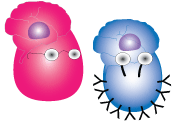
Introduction
The T and the B lymphocytes, called T and B cells for short, are our adaptive immune defenders. Before we get to know how they differ, we will focus on some aspects of their characteristics that are very similar. These include the way they specifically recognise antigens via their antigen specific molecule, which in T cells is the T cell receptor (TCR) and in B cells is the surface bound immunoglobulin (Ig), which together with another molecule is known as the B cell receptor (BCR). As you will find in the following pages, there are some structural similarities between TCR and Ig which makes them recognise antigens with such precision, and also similarities in the way these structures are made which makes it possible for these cells to generate an almost infinite number of different antigen specificities. T and B cells are also alike in the way they live their lives, which we also will draw your attention to before we then move our focus to their individual attributes in later sections. But first let's start with what they have in common!